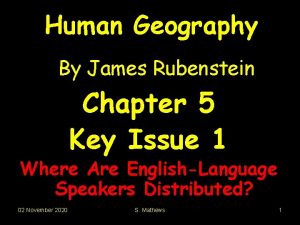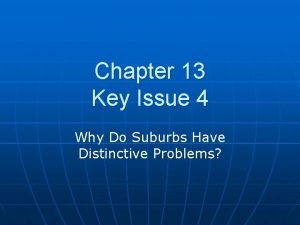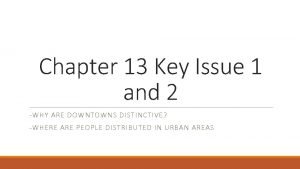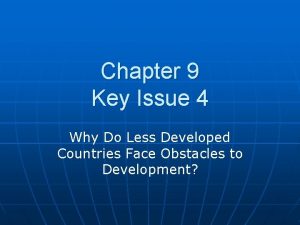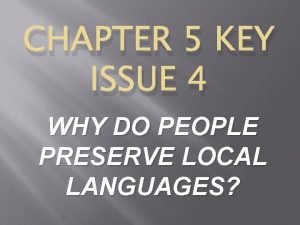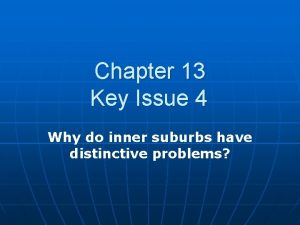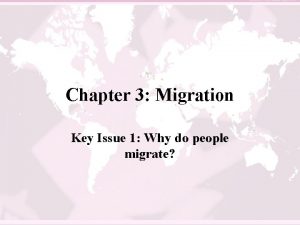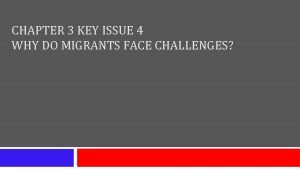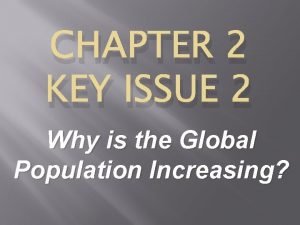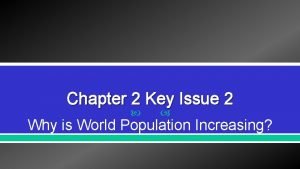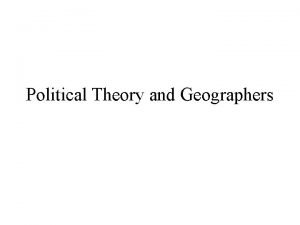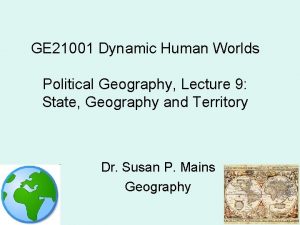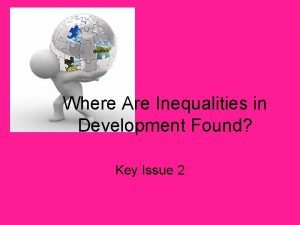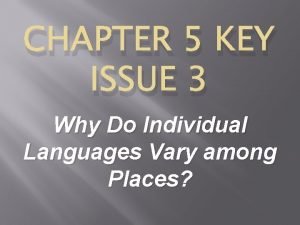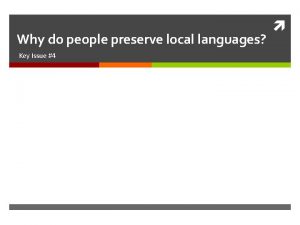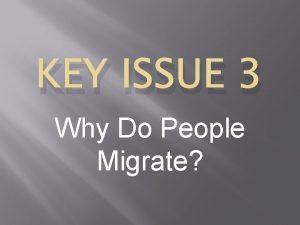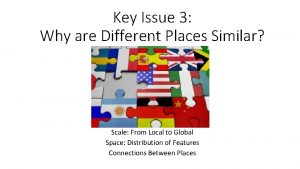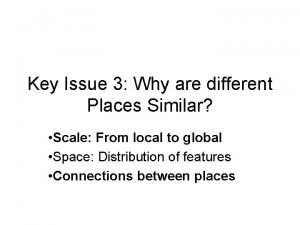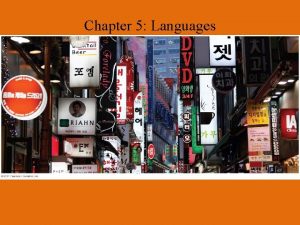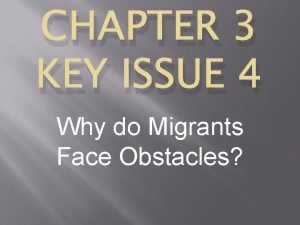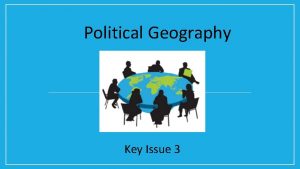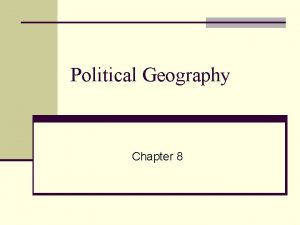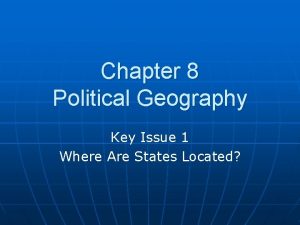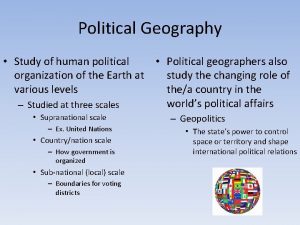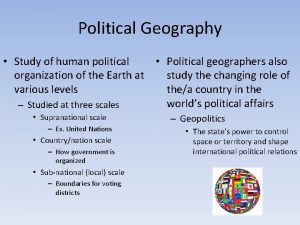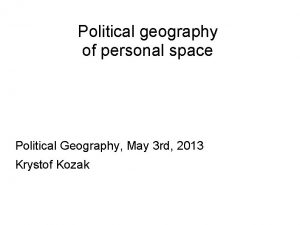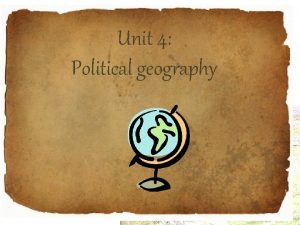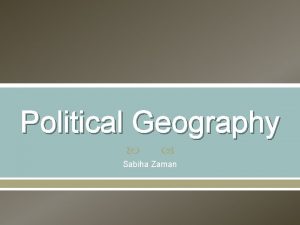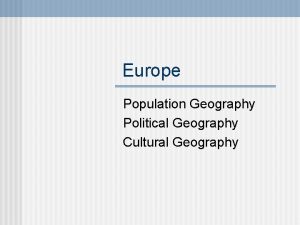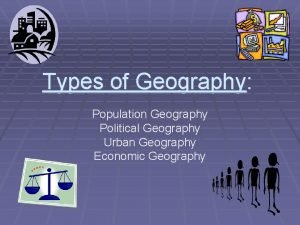Chapter 8 Key Issue 1 Political Geography Key













































- Slides: 45

Chapter 8: Key Issue 1 – Political Geography –

Key Issue #3 Where Are Ethnicities Distributed? • Learning Outcome 8. 3. 1: • Learning Outcome 8. 3. 2: • Learning Outcome 8. 3. 3: • Learning Outcome 8. 3. 4: • Learning Outcome 8. 3. 6: • Learning Outcome 8. 3. 7: Describe the types of cultural boundaries between states. Describe the types of physical boundaries between states. Describe the five shapes of states. Explain the concept of gerrymandering and three ways it is done. Describe examples of gerrymandering.

Key Issue 3: Why Do Boundaries Cause Problems? • A boundary is an invisible line that marks the extent of a state’s territory. • Historically, frontiers rather than boundaries separated states. • A frontier is a zone where no state exercises complete political control. • Frontiers between states have been replaced by boundaries.

Key Issue 3: Why Do Boundaries Cause Problems? • Boundaries may be classified into three categories: • Cultural boundaries follow the distribution of cultural features. • Geometric boundaries are based on human constructs, such as straight lines. • Physical boundaries coincide with significant features of the natural landscape.

• Boundary locations may be the source of conflict, both within a country and with its neighbors. • Religious Boundary: • Ireland is divided by a boundary based on the separation between two major religions: Roman Catholicism in the Republic of Ireland, and Protestantism in Northern Ireland. Key Issue 3: Why Do Boundaries Cause Problems?

Ethnic Boundary: Cyprus • Two nationalities predominantly inhabit the island of Cyprus: Greek and Turkish. • Depite its proximity to Turkey, only 24 % of the island’s occupants are of Turkish descent, while 63 % are Greek.

Ethnic Boundary: Cyprus • Independence from Britain in 1960, the Turkish minority guaranteed a substantial share of elected offices and control over its own education, religion, and culture. • Cyprus has yet to peacefully integrate both nationalities.

Ethnic Boundary: Cyprus • A wall has been built separating the northern area of the island occupied by ethnic Turks, and the southern area inhabited by Greeks. • Today, a portion of the wall has been demolished, and the two nationalities can freely travel between the two areas.

Geometric Boundaries • North American and North Africa are two regions where geometric boundaries are particularly prominent parts of the political landscape. • Part of the northern U. S. boundary with Canada is a 1, 300 -mile straight line along 49° north latitude.

Geometric Boundary: North Africa • Boundaries between Algeria, Libya, and Egypt on the north and Mali, Niger, Chad, and Sudan on the south are generally geometric. • These boundaries can largely be attributed to the colonial legacy of Africa.

Geometric Boundary: South Pole • The South Pole contains the only large landmass on Earth’s surface that is not part of a state. • States may establish research stations there for scientific investigations, but no military activities are permitted.

Physical Boundaries • Physical features of the landscape can be appropriate boundaries because they are easily seen, both on a map and on the ground. • Deserts, mountains, and water are three types of physical elements serve as physical boundaries.

Desert Boundaries • A desert can act as an effective boundary, as desert terrain is generally hard to traverse and sparsely populated. • Desert boundaries are common in North Africa and Asia. • Above – Chile / Bolivia- Atacama Desert

Mountain Boundaries • Mountains can similarly be effective boundaries, especially if they are hard to traverse, are generally sparsely populated, and are permanent installations of the landscape. • If passes are closed during winter months on account of intense storms, contact between nationalities living on opposite sides may be limited or totally impossible.

• Rivers, lakes, and oceans are the most common physical features used as physical boundaries. • While water boundaries may seem to be permanent, the precise position of water may change over time. • Rio Grande boundary Water Boundaries

• The origin and evolution of particular boundaries provide extremely important clues for understanding current political tensions. • Subsequent boundaries are drawn after a population has established itself and respect existing spatial patterns of certain social, cultural and ethnic groups. Subsequent Boundaries

• When a boundary is given a region before it is populated, it is called an antecedent boundary. • Carries little significance until area becomes more populated. • Ex. – Western boundary between U. S. and Canada Antecedent Boundaries

• The opposite of antecedent, is superimposed boundaries which are drawn after a population has been settle in an area and do not pay much attention to the social, cultural and ethnic compositions of the people they divide. • Ex. – boundaries of Africa during colonialism still remain. Superimposed Boundaries

• A relic boundary is a national border that no longer exists, but has left some imprint on the local or environmental geography. Relic Boundaries

The Law of the Sea • The Law of the Sea identifies three types of water boundaries: • Territorial waters. Up to 12 nautical miles from shore, a state may set laws regulating passage by ships registered in other states.

The Law of the Sea • Contiguous zone -between 12 and 24 nautical miles from shore, a state may enforce laws concerning pollution, taxation, customs, and immigration. • Exclusive economic zone - between 24 and 200 nautical miles, a state has the sole right to the fish and other marine life. • Disputes = International Court of Justice - primary judicial branch of the United Nations (UN). • Seated in the Peace Palace in The Hague, Netherlands.

Shape of States • The shape of a state controls the length of its boundaries with other states. • Therefore, the shape affects the potential for communication and conflict with neighbors.

Shape of States • The shape is also a part of its unique identity. • Beyond its position as a centripetal force, the shape of a state can impact the degree of successful of internal administration and can affect social unity. • States may take on one of five basic shapes: compact, elongated, prorupted, fragmented, or perforated.

Compact States: Efficient • In a compact state, the distance from the center to any boundary does not vary significantly. • The ideal theoretical compact state would be shaped like a circle, with the capital at the center and with the shortest possible boundary to defend. • A compact state has efficient communication and transportation. (Belgium – 141 miles wide)

Elongated States: Potential Isolation • An elongated state has a long and narrow shape. • Elongated states may suffer from poor internal communications. • A region located at an extreme end of the elongation might be isolated from the capital, which is usually placed near the center.

Prorupted States: Access or Disruption • An otherwise compact state with a large projecting extension is a prorupted state. • Proruptions can provide a state with access to a resource, such as water. • Proruptions are also used to separate two states that would otherwise share a boundary.

Perforated States: South Africa • A state that completely surrounds another one is a perforated state. • In this situation, the state that is surrounded may face problems of dependence on, or interference from, the surrounding state. • South Africa completely surrounds the state of Lesotho.

Fragmented States: Problematic • A fragmented state includes several discontinuous pieces of territory. • Fragmented states separated by water can face problems and costs associated with communications and maintaining national unity and issues within the states in between the fragments.

• Landlocked states have difficulty engaging in international trade because they lack direct access to the ocean. • A landlocked state is completely surrounded by other countries and most common in Africa, (14 of 54). • The prevalence of landlocked states in Africa is a remnant of the colonial era - Forcing states to cooperate with neighboring states that have seaports. Landlocked States

Governing States • A state has two types of government: a national government and local governments. • At the national scale, a government can be more or less democratic. • At the local scale, the national government can determine how much power to allocate to local gov.

National Scale: Regime Types • A democracy is a country in which citizens elect leaders and can run for office. • An autocracy is a country that is run according to the interests of the ruler rather than the people. • An anocracy is country that is not fully democratic or fully autocratic, but displays a mix of the two types.

National Scale: Regime Types • Democracies and autocracies differ in three essential elements: selection of leaders, citizen participation, and checks and balances. • The Arab Spring shows how the world is becoming more democratic.

Local Scale: Unitary and Federal States • State organization of internal territory falls into a continuum from a unitary state and a federal state. • A unitary state places most power in the hands of central government officials. • A federal state allocates strong power to units of local government within the country.

National Scale: Regime Types • Under federalism, governments bestow autonomous powers upon their local territories rather than centrally controlling the entire country. • These governments are called federal states. • U. S. , Canada and Mexico are all federal states – designating a certain level of political power to local areas, allowing voting individuals greater influence on political processes.

Unitary States • The unitary government system works best in nationstates characterized by few internal cultural differences and a strong sense of national unity. • Smaller states are also more likely to adopt a unitary government system. • Some multinational states have adopted unitary systems so that the values of one nationality can be imposed on others, such as in Kenya and Rwanda.

Federal States • Local government poses considerable authority to adopt their own laws in a federal state. • The federal system empowers different nationalities, especially if they live in separate regions of the country.

Federal States • The federal system is more suitable for large states because the national capital may be too remote to provide effective control over isolated regions. • Most of the world’s large states are federal, including Russia, Canada, the United States, Brazil, and India.

Electoral Geography • Geographic organization of the state into locally governed areas has dramatic implication for individual representation. • Congressional representatives serve the people from their own home district. • Even our Presidents are chosen by a state-by-state basis.

Electoral Geography • In 2000, Al Gore won the popular vote, but lost the electoral vote to George W. Bush. • In 2016, Hillary Clinton won the popular vote. • The Electoral college consists of a specific number of electors from each state – (Why? – Slavery 3/5)

Electoral Geography • The process of redrawing legislative boundaries for the purpose of benefiting the party in power is called gerrymandering. • The boundaries separating the 435 legislative districts within the U. S. are redrawn periodically to ensure that each district has approximately the same population.

Electoral Geography • Boundaries must be redrawn because migration inevitably results in some districts gaining population and losing population. • The political party in control of the state legislature naturally attempts to redraw boundaries to improve the chances of its supporters to win seats.

Geography of Gerrymandering • A measure of each Congressional district’s level of gerrymandering was devised by the Washington Post. • This score was determined by calculating the ratio of the area of the district to the area of a circle with the same perimeter.

• A district that follows a regular compact shape has a lower score than a district with irregularities. Geography of Gerrymandering

• A district that follows a regular compact shape has a lower score than a district with irregularities. • The state judged to have the most gerrymandering is North Carolina. Geography of Gerrymandering

• Competing plans by Democrats and Republicans to draw boundaries for Nevada Geography of Gerrymandering
 Chapter 5 key issue 1 ap human geography
Chapter 5 key issue 1 ap human geography Frq ap human geography format
Frq ap human geography format Stateless nation
Stateless nation Chapter 13 key issue 1
Chapter 13 key issue 1 Key issue 1 why are downtowns distinctive
Key issue 1 why are downtowns distinctive Key issue 1: where are services distributed?
Key issue 1: where are services distributed? Chapter 12 key issue 1
Chapter 12 key issue 1 Chapter 11 key issue 4
Chapter 11 key issue 4 Chapter 9 key issue 4
Chapter 9 key issue 4 Chapter 5 key issue 1
Chapter 5 key issue 1 Chapter 5 key issue 4
Chapter 5 key issue 4 Chapter 4 key issue 3
Chapter 4 key issue 3 Chapter 13 key issue 4
Chapter 13 key issue 4 Key issue 2 where are consumer services distributed
Key issue 2 where are consumer services distributed Chapter 6 key issue 4
Chapter 6 key issue 4 Chapter 5 key issue 2
Chapter 5 key issue 2 Chapter 4 key issue 2
Chapter 4 key issue 2 Chapter 3 key issue 1
Chapter 3 key issue 1 Chapter 3 key issue 4
Chapter 3 key issue 4 Chapter 2 population and health key issue 3
Chapter 2 population and health key issue 3 Chapter 2 key issue 2
Chapter 2 key issue 2 Chapter 2 key issue 1
Chapter 2 key issue 1 Bulk gaining industry vs bulk reducing
Bulk gaining industry vs bulk reducing Classification of boundaries in political geography
Classification of boundaries in political geography Objectives of political geography
Objectives of political geography Population density map australia
Population density map australia Relationship between political science and geography
Relationship between political science and geography Map europe 1990
Map europe 1990 Boundaries ap human geography
Boundaries ap human geography Compare geometric boundaries and antecedent boundaries.
Compare geometric boundaries and antecedent boundaries. Political geography
Political geography Centrifugal forces geography
Centrifugal forces geography The cultural geography of europe chapter 12 answer key
The cultural geography of europe chapter 12 answer key Vocabulary activity 15 the cultural geography of russia
Vocabulary activity 15 the cultural geography of russia 5 themes of geography ap human geography
5 themes of geography ap human geography Where are inequalities in development found
Where are inequalities in development found Key issue 2 why are situation and site factors important
Key issue 2 why are situation and site factors important Key issue 1 why do services cluster downtown
Key issue 1 why do services cluster downtown Key issue 1 where did agriculture originate
Key issue 1 where did agriculture originate Key issue 3 why do individual languages vary among places
Key issue 3 why do individual languages vary among places Key issue 4: why do people preserve local languages?
Key issue 4: why do people preserve local languages? Key issue 3 why do people migrate
Key issue 3 why do people migrate How and why are places similar
How and why are places similar Key issue 3 why are different places similar
Key issue 3 why are different places similar Key issue 1 where are languages distributed
Key issue 1 where are languages distributed Key issue 4: why do migrants face obstacles?
Key issue 4: why do migrants face obstacles?
